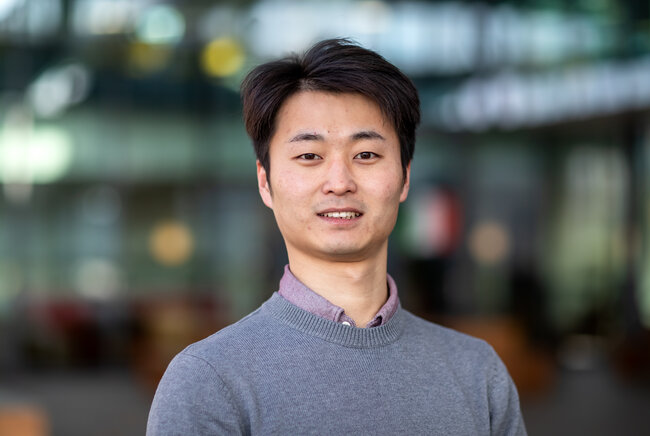The origin of dark current and trap states in organic photodiodes
Xiao Ma defended his PhD thesis at the department of Applied Physics on May 22nd.

With ever-growing demands for light sensing and imaging in industry and consumer electronics, organic photodiodes are attracting extensive attention for emerging applications such as wearable monitoring, biomedical imaging, surveillance systems, and machine vision. Organic semiconductors present high tunability in optoelectronic properties and provide a promising pathway to achieve flexible and lightweight devices. For his PhD research, Xiao Ma looked at ways to deal with noise and how it relates to so-called dark current density in organic photodiodes.
Despite significant progress in developing donor-acceptor (D−A) bulk-heterojunction (BHJ) organic photodiodes (OPDs) with near 100% external quantum efficiency (EQE), the specific detectivity (D*) of OPDs is still limited by the high noise current spectral density that primarily stems from the reverse bias dark current density (Jd). Thus, understanding the factors that determine Jd is an important prerequisite to further reduce the Jd and thereby improve D*.
History first
To address this question, Xiao Ma compiled an overview of the basic development history of organic photodiodes, which explains how the organic active layer evolved from the single-component layer to the BHJ layer for state-of-the-art photovoltaic devices. Due to the disordered nature of organic semiconductors, the presence of energetic disorder i.e., trap states, is commonly observed in many organic electronic devices.
Thus, various techniques or methods that can be used to characterize the trap states were illustrated and compiled by Ma, including sub-bandgap EQE measurement, thermal admittance spectroscopy, light intensity dependent EQE measurement, and temperature dependent current density – voltage characteristics (J–V).
Investigation
To investigate the origin of Jd, Ma and his collaborators in the department of Applied Physics employed temperature dependent J–V measurements in OPDs with Jd down to 10−9 mA cm−2, where the shunt current was substantially eliminated by the edge cover layer. The activation barrier of Jd was determined by the activation energy (Ea) extracted from the slope in the Arrhenius plot.
Ma discovered that the activation energy of OPDs with the same BHJ active layer did not change over different charge transport layers or contacts. Ea remained the same even for OPDs with an extra hole blocking layer (C60), which has a much deeper HOMO level. However, for diode-based on polymer-only active layer, its Ea decreased dramatically with the addition of C60 leading to the formation bi-layer diode. These indicates that the activation barrier of Jd is formed within the active layer and generation of Jd happens at the D–A interface. In the end, for a variety of donor-acceptor BHJs, Ma found that the activation energy of Jd is lower than the effective bandgap of the blends, by ca. 0.3 to 0.5 eV, suggesting there are intra-gap states in various BHJs.
Intra-gap states in more detail
To characterize the intra-gap states in more detail, Ma employed ultra-sensitive sub-bandgap photocurrent measurements for the same group of BHJs in both semi-transparent and opaque stack.
A distinct low-energy band was observed below the exponential band edge of the BHJ for each D-A combination. These low-energy transitions correspond to charge generation by absorption via the intra-gap states. The low-energy onsets (Eonset) in these spectra represents the lowest-energy photo-excitations that generate photocurrent in the BHJs. The correspondence between Ea and Eonset proves that thermal and photo-induced charge carrier generation have the similar minimal energy for charge generation and use the same intra-gap states in BHJ layers, and lie close to the band edges.
The origin of trap states?
However, it is still unclear where trap states in the BHJs come from. To explore their origin, Ma compared the the activation energy of BHJs with the same polymer donor and three non-fullerene acceptors (NFAs). It was found that Jd and Ea strongly depend on the hole transport level of acceptors. Sub-bandgap EQE spectra of polymer donor-only and NFA-only photodiodes suggest that trap states in BHJs are derived from polymer donors rather than NFAs.
Combined with the activation energy of each OPD based on different NFAs, Ma concluded that the activation barrier of Jd is formed between NFA LUMO and trap states above the polymer HOMO of approximately 0.3−0.4 eV. Moreover, the light intensity-dependent photocurrent (Jph) measurement under ultra-low light intensity, down to 10−7 mW cm−2, revealed an unreported first-order loss, which is attributed to trap-induce photocurrent recombination.
The presence of this first-order photocurrent loss in BHJs and polymer-only diodes was not observed in NFA-only diodes suggesting that the trap states in BHJs are derived from polymers rather than NFAs. Ma’s results emphasize the critical and detrimental role of trap states in polymers in limiting the Jd of NIR OPDs, and shed new light on future optimization strategies, which may target polymer material properties rather than device engineering.
Title of PhD thesis: The Origin of Dark Current and Trap States in Organic Photodiodes. Supervisors: René Janssen, Gerwin Gelinck, and Stefan Meskers.
Media contact
Latest news


